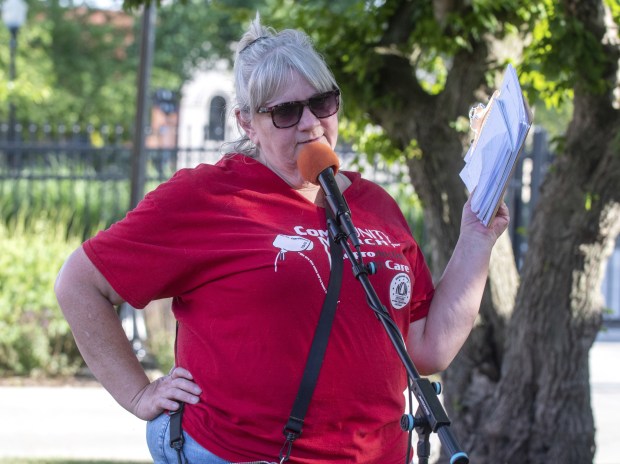Anti-abortion protestors plan to be on the Porter County Courthouse lawn at noon Tuesday to bring attention to a U.S. Supreme Court case involving the drug mifepristone, which is the most common way to end a pregnancy.
Pro-abortion rights protestors will be there next week.
The court will hear oral arguments Tuesday on FAA v. Alliance for Hippocratic Medicine, two years after the court overturned Roe v. Wade and cleared the way for bans or severe restrictions on abortion.
Richard Stith, of Valparaiso, is a board member of the national Consistent Life Network, which opposes wars, executions and abortions.
“We’re calling on Walgreens and CVS not to sell drugs that take the lives of unborn children with beating hearts and also endanger their mothers,” he said. “We have so far collected about 1,300 local signatures asking these two pharmacy chains to stop trying to sell abortion.”
Julie Storbeck, president of Northwest Indiana NOW (National Organization for Women), wants to retain access to mifepristone.
“That particular pill is extremely safe. It is used to treat a lot of medical conditions. It is used to treat miscarriages,” she said.
Julie Storbeck, President of Northwest Indiana National Organization for Women and Indiana NOW, speaks during a protest at the Porter County Courthouse in Valparaiso, Indiana Friday June 24, 2022. Earlier in the day the Supreme Court announced the overturning of Roe v. Wade. (Andy Lavalley for the Post-Tribune)
“It’s mind-boggling that they would risk the lives of people who would get pregnant,” Storbeck said.
Stith believes the federal Food and Drug Administration took a number of shortcuts over the years. Political or ideological pressure might have influenced the approval process for mifepristone, he said.
The issue boils down to whether abortion is akin to elective surgery or a matter of women’s sovereignty over their bodies, Stith said.
“The fact that the Supreme Court is even taking this case is beyond the pale,” Storbeck said. “It just shows a breakdown in our judicial system.
“It’s just pure propaganda by the far-right agenda,” she said.
Storbeck hopes the abortion issue will motivate voters to elect candidates in November who will support access to abortion.
She told of being at an area hospital because of a miscarriage and bleeding, but being sent home because the hospital won’t do abortions.
Protests on the courthouse lawn have drawn a lot of attention, mostly in support of retaining access to abortion, Storbeck said.
“We’ve had so many people tell us that because we were standing there on that corner their child has said, ‘What’s that all about?’ and it has opened the door for people to have these conversations with their children where they were like all kinds of awkward, like discussing the birds and the bees.
“When we’re out there and we’re normalizing the ‘A’ word and people are seeing and kids are asking parents, now, well, I’ve got you trapped in the car and you can’t get out. I’ve got 10 minutes of this conversation with you,” Storbeck said.
“I think the more that people are seeing these stories of 10-year-old children being forced to carry pregnancies, of abortion providers being harassed, of being threatened when they see that they themselves can no longer get access to healthcare because the OB/GYN’s are closing their doors and they’re moving their practices to Illinois,” the more they will support access to abortion, she said.
Stith said most people who drive by anti-abortion protestors don’t react, but the majority of those who do are supportive. Some of the ones who don’t are vehement, he added.
The Supreme Court is reviewing a federal appellate court ruling that would limit access to mifepristone, which was used in nearly two-thirds of all abortions in the United States last year.
At stake is access to the drug through the mail and other restrictions, even in states where abortion is legal. The restrictions could shorten the time when mifepristone can be used in pregnancy, to seven weeks from the current 10.
Doug Ross is a freelance reporter for the Post-Tribune.
The Associated Press contributed.





